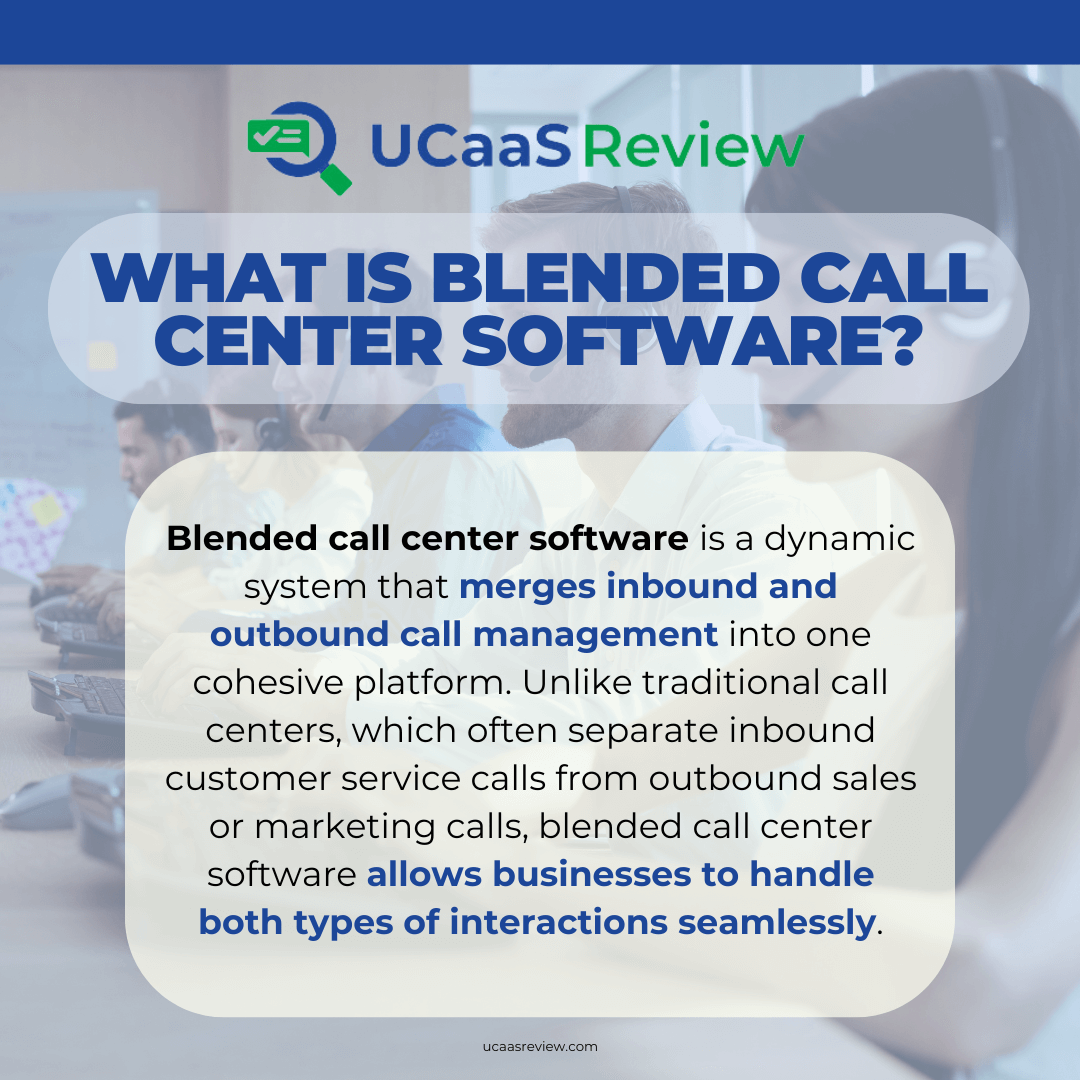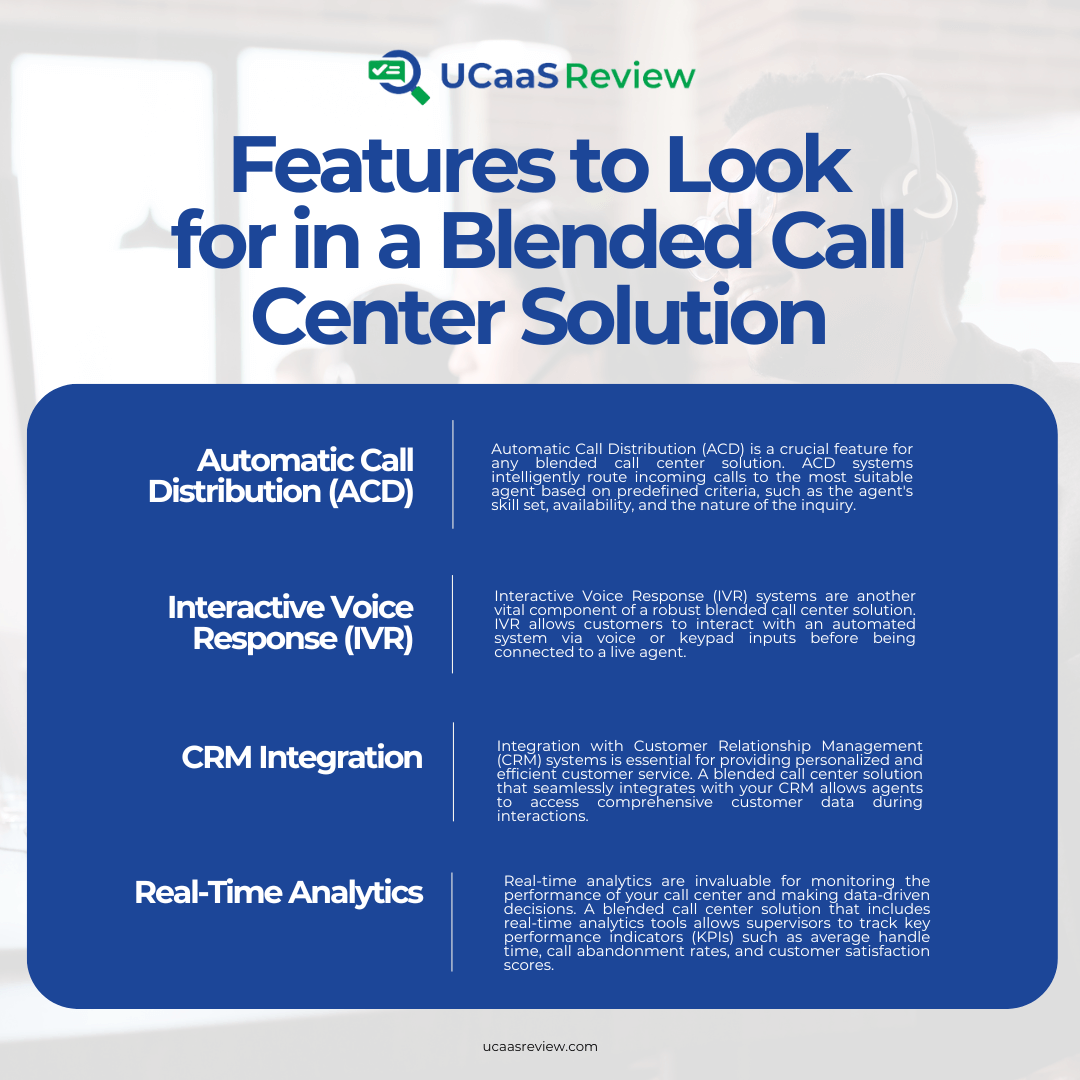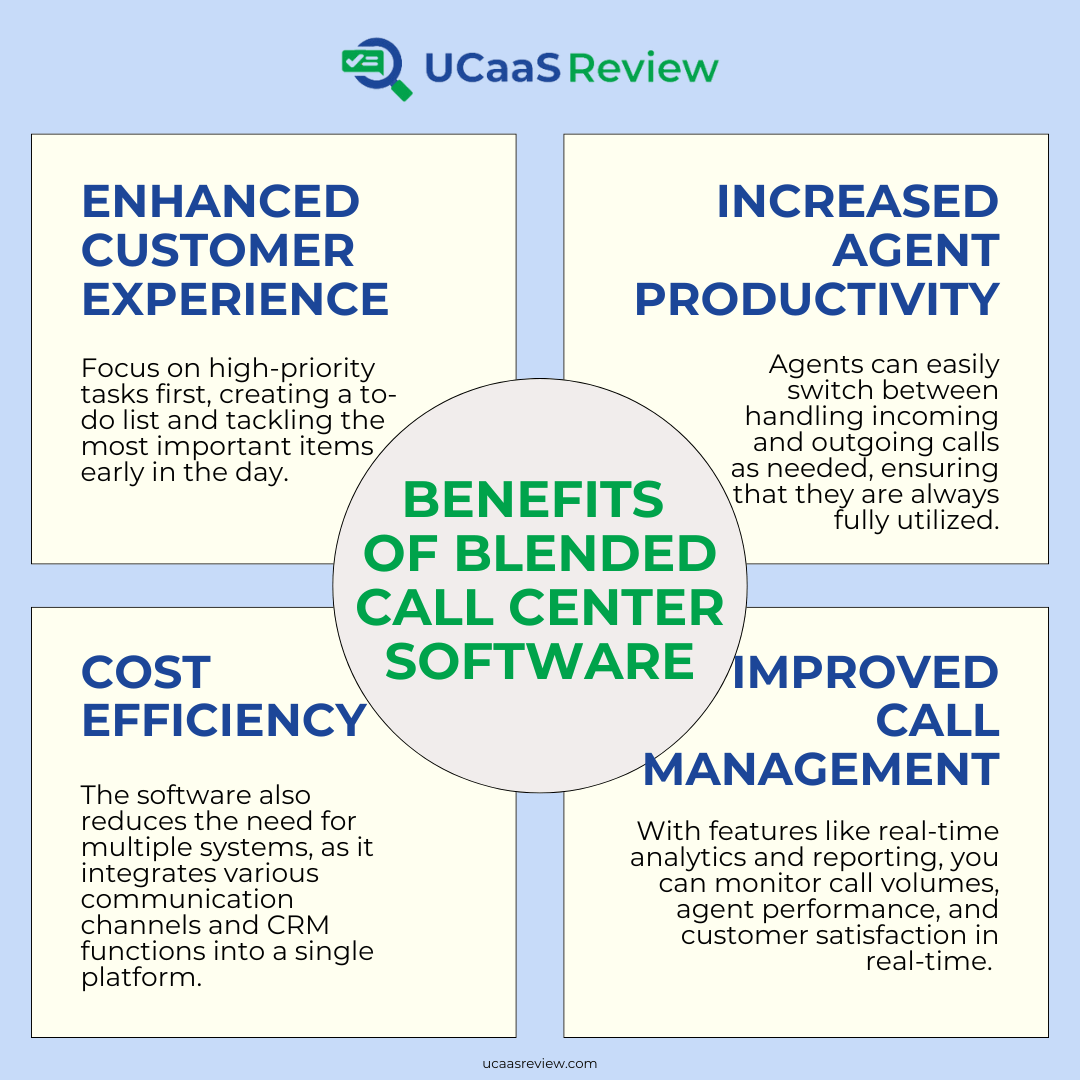Blended call center software is a dynamic system that merges inbound and outbound call management into one cohesive platform. Unlike traditional call centers, which often separate inbound customer service calls from outbound sales or marketing calls, blended call center software allows businesses to handle both types of interactions seamlessly. This integration is crucial for companies that want to optimize their resources, improve customer service, and increase their overall operational efficiency.
In a traditional call center setup, agents are typically divided into two groups: those who handle incoming calls and those who make outbound calls. This division can lead to inefficiencies, especially when call volumes fluctuate. For instance, during peak hours, inbound agents may be overwhelmed with calls, while outbound agents might have less to do. Blended call center software solves this problem by enabling agents to switch between inbound and outbound calls based on demand, ensuring that no resource is underutilized.
But the benefits of blended call center software go beyond just better resource management. It also enhances customer service by reducing wait times and ensuring that customer inquiries are addressed promptly, regardless of whether the interaction started as an inbound or outbound call. This flexibility not only improves the customer experience but also increases the likelihood of successful sales interactions, as agents can respond to leads and customer queries more effectively.
Furthermore, blended call center software is designed to integrate with various customer relationship management (CRM) systems, allowing for a more personalized and informed interaction with customers. When an agent has access to a customer’s history, preferences, and past interactions, they can provide a more tailored service, which can significantly improve customer satisfaction and loyalty.

Key Differences Between Blended Call Center Software and Traditional Call Center Software
When comparing blended call center software to traditional call center systems, several key differences highlight why more businesses are making the switch. These differences primarily revolve around customer engagement capabilities, operational efficiency, and the ability to integrate with other business systems.
Customer Engagement Capabilities
One of the most significant advantages of blended call center software is its ability to enhance customer engagement. Traditional call centers often operate in silos, with separate teams handling inbound and outbound calls. This division can lead to inconsistent customer experiences, as there’s often a disconnect between the support customers receive and the follow-up interactions they might have later.
Blended call center software, on the other hand, allows agents to handle both inbound and outbound calls, leading to more consistent and personalized customer interactions. For example, an agent who initially assists a customer with a support issue through an inbound call can later follow up with that same customer via an outbound call to ensure their problem was fully resolved. This continuity helps build stronger customer relationships and improves overall satisfaction.
Moreover, with features like Automatic Call Distribution (ACD) and Interactive Voice Response (IVR), blended systems ensure that customers are quickly routed to the most appropriate agent based on their needs, further enhancing the customer experience.
Operational Efficiency
Blended call center software also excels in operational efficiency. In traditional call centers, the separation of inbound and outbound tasks can lead to inefficiencies, especially during periods of fluctuating call volumes. Inbound agents may be overwhelmed during peak times, while outbound agents may sit idle during slower periods.
Blended call center software addresses this issue by allowing agents to switch seamlessly between inbound and outbound tasks as needed. This flexibility ensures that no resource is wasted, and that the call center operates at peak efficiency at all times. This adaptability is particularly beneficial for businesses with seasonal spikes in activity, where the ability to reallocate agent tasks dynamically can make a significant difference in maintaining service levels.
Integration with CRM and Other Systems
Another critical difference is the ease of integration with other business systems. Traditional call centers often struggle with outdated software that doesn’t easily connect with modern Customer Relationship Management (CRM) systems or other business tools. This lack of integration can lead to inefficiencies, such as agents not having access to up-to-date customer information during calls.
Blended call center software is designed with integration in mind. It seamlessly connects with CRM systems, allowing agents to access comprehensive customer profiles, including past interactions, preferences, and purchase history. This integration enables more personalized customer interactions and helps agents resolve issues more quickly and effectively.
Preparing Your Agents for a Blended Call Center Environment
Implementing blended call center software is only as effective as the agents who use it. To fully leverage the benefits of this technology, it’s crucial to ensure that your agents are well-prepared to operate in a blended call center environment. This preparation involves comprehensive training programs and ongoing performance monitoring to help agents adapt to the new system and maintain high levels of productivity and customer satisfaction.
Training Programs
The first step in preparing your agents for a blended call center is to design and implement specialized training programs. These programs should cover both the technical aspects of the software and the practical skills needed to manage both inbound and outbound calls effectively.
- Technical Training: Agents must be comfortable with the functionalities of the blended call center software, including features like Automatic Call Distribution (ACD), Interactive Voice Response (IVR), and integration with CRM systems. Hands-on training sessions can help agents familiarize themselves with these tools, enabling them to navigate the system efficiently during live calls.
- Role-Specific Training: Since agents in a blended environment will handle a mix of inbound and outbound calls, it’s important to provide training that addresses the nuances of each type. For instance, inbound calls often require strong problem-solving skills and empathy, while outbound calls may focus more on persuasion and sales tactics. Cross-training can help agents develop a versatile skill set that allows them to switch roles seamlessly as call volumes fluctuate.
- Soft Skills Development: In addition to technical training, agents should also be trained in soft skills like communication, active listening, and conflict resolution. These skills are essential for delivering high-quality customer service, regardless of whether the interaction is inbound or outbound.
Performance Monitoring
Once your agents are trained, continuous performance monitoring is essential to ensure that they are effectively applying what they’ve learned. Monitoring tools can track key metrics such as average handle time, first call resolution, and customer satisfaction scores, providing insights into each agent’s performance.
- Real-Time Monitoring: Utilizing real-time monitoring tools allows supervisors to listen in on calls and provide immediate feedback. This helps to address any issues as they arise and ensures that agents are consistently meeting the expected service standards.
- Regular Feedback Sessions: Scheduled feedback sessions can help agents reflect on their performance and identify areas for improvement. During these sessions, supervisors should review the data collected through monitoring tools and provide constructive feedback that encourages agents to develop their skills further.
- Ongoing Training and Development: Performance monitoring should be coupled with ongoing training initiatives. As agents adapt to the blended environment, continuous learning opportunities—such as advanced training modules or refresher courses—can help them stay sharp and up-to-date with the latest best practices.
By investing in comprehensive training programs and robust performance monitoring, businesses can ensure that their agents are well-prepared to thrive in a blended call center environment.
Features to Look for in a Blended Call Center Solution
When selecting a blended call center solution, it’s essential to focus on the features that will most effectively meet your business’s needs. These features not only enhance the efficiency of your operations but also significantly improve the quality of customer interactions. Here are some of the key features to consider:

Automatic Call Distribution (ACD)
Automatic Call Distribution (ACD) is a crucial feature for any blended call center solution. ACD systems intelligently route incoming calls to the most suitable agent based on predefined criteria, such as the agent’s skill set, availability, and the nature of the inquiry. This ensures that customers are connected with the right person quickly, reducing wait times and improving first call resolution rates.
ACD is particularly beneficial in a blended environment where agents handle both inbound and outbound calls. By using ACD, businesses can ensure that inbound calls are prioritized and handled efficiently while still allowing agents to make outbound calls during quieter periods.
Interactive Voice Response (IVR)
Interactive Voice Response (IVR) systems are another vital component of a robust blended call center solution. IVR allows customers to interact with an automated system via voice or keypad inputs before being connected to a live agent. This technology can handle simple inquiries, direct calls to the appropriate department, or even resolve issues without agent intervention.
For blended call centers, IVR systems help manage high call volumes by filtering and routing calls more effectively. This not only improves the customer experience by reducing wait times but also frees up agents to focus on more complex interactions that require a human touch.
CRM Integration
Integration with Customer Relationship Management (CRM) systems is essential for providing personalized and efficient customer service. A blended call center solution that seamlessly integrates with your CRM allows agents to access comprehensive customer data during interactions. This includes past interactions, purchase history, and customer preferences.
With this information at their fingertips, agents can tailor their approach to each customer, enhancing the overall experience. For instance, when an agent receives an inbound call, they can immediately see the customer’s history and anticipate potential issues or needs. Similarly, during outbound calls, agents can reference previous interactions to offer relevant products or services.
Real-Time Analytics
Real-time analytics are invaluable for monitoring the performance of your call center and making data-driven decisions. A blended call center solution that includes real-time analytics tools allows supervisors to track key performance indicators (KPIs) such as average handle time, call abandonment rates, and customer satisfaction scores.
These insights enable you to identify trends, optimize call flows, and provide targeted feedback to agents. For example, if the analytics show that certain types of calls are taking longer to resolve, you can investigate and adjust training or processes to address the issue.
Incorporating real-time analytics into your blended call center not only improves operational efficiency but also enhances the customer experience by ensuring that issues are addressed promptly and effectively.
Benefits of Blended Call Center Software
Investing in blended call center software brings numerous benefits that can significantly enhance your business operations. From improving customer satisfaction to boosting agent productivity, the advantages of this technology are substantial. Here are some of the most compelling benefits:

Alt text: Infographic titled “Benefits of Blended Call Center Software” with four sections: Enhanced Customer Experience, Increased Agent Productivity, Cost Efficiency, and Improved Call Management.
Enhanced Customer Experience
Blended call center software is designed to provide a seamless customer experience by ensuring that every call—whether inbound or outbound—is handled efficiently and effectively. With the ability to integrate various communication channels, such as voice, email, and chat, blended call centers offer customers multiple ways to interact with your business. This multi-channel approach not only makes it easier for customers to reach you but also ensures that their inquiries are addressed promptly, no matter how they choose to contact you.
Moreover, the integration with CRM systems allows agents to access detailed customer information in real-time. This means that every interaction can be personalized based on the customer’s history, preferences, and previous interactions with your company. Such personalized service can lead to higher customer satisfaction and loyalty, as customers feel valued and understood.
Increased Agent Productivity
One of the key operational benefits of blended call center software is the increase in agent productivity. In traditional call centers, agents are often restricted to either inbound or outbound calls, which can lead to inefficiencies—particularly during periods of fluctuating call volumes. However, with blended call center software, agents can easily switch between handling incoming and outgoing calls as needed, ensuring that they are always fully utilized.
This flexibility not only maximizes the use of your workforce but also helps to reduce downtime and idle time, which are common challenges in traditional call centers. Additionally, features like Automatic Call Distribution (ACD) and Interactive Voice Response (IVR) further streamline the call-handling process, allowing agents to focus on more complex tasks rather than routine call routing or simple queries.
Cost Efficiency
Implementing blended call center software can lead to significant cost savings for your business. By optimizing the use of your agents and reducing the need for separate teams to handle inbound and outbound calls, you can lower labor costs and improve overall efficiency. The software also reduces the need for multiple systems, as it integrates various communication channels and CRM functions into a single platform.
Furthermore, the enhanced efficiency and productivity that come with a blended call center can lead to faster resolution times and fewer repeat calls, which reduces the overall cost per call. The result is a more cost-effective operation that delivers better service at a lower price point.
Improved Call Management
Blended call center software offers superior call management capabilities, allowing you to balance workloads and manage call flows more effectively. With features like real-time analytics and reporting, you can monitor call volumes, agent performance, and customer satisfaction in real-time. This data-driven approach enables you to make informed decisions on the fly, adjusting resources as needed to maintain high service levels.
Additionally, the ability to handle both inbound and outbound calls within the same system ensures that no customer is left waiting unnecessarily, and no sales opportunity is missed. This comprehensive call management capability is essential for businesses that want to maintain a competitive edge in today’s fast-paced market.
Launching Your Blended Call Center Software: What to Expect
Implementing blended call center software is a strategic move that can revolutionize your customer service operations. However, like any significant technological upgrade, it requires careful planning and execution. Here’s what you can expect when launching your blended call center software, along with some best practices to ensure a smooth transition.
Implementation Timeline
The timeline for implementing blended call center software can vary depending on the size of your organization, the complexity of your existing systems, and the specific features you need. On average, businesses can expect the process to take anywhere from a few weeks to several months.
- Initial Planning and Needs Assessment (1-2 Weeks): Start by evaluating your current call center operations and identifying the specific needs and goals you want the blended software to address. This stage involves collaboration between your IT department, call center managers, and key stakeholders to ensure that everyone is aligned on the objectives.
- Vendor Selection and Customization (2-4 Weeks): Once you’ve identified your needs, the next step is to select the right vendor. This involves comparing different solutions, requesting demos, and negotiating contracts. After selecting a vendor, you’ll work with them to customize the software to fit your business’s specific requirements.
- Installation and Integration (3-6 Weeks): The installation phase includes setting up the software, integrating it with your existing systems (such as CRM and communication tools), and configuring it according to your workflow. This stage may also involve migrating data from your old systems to the new software.
- Training and Testing (2-4 Weeks): Before going live, it’s crucial to train your agents and supervisors on the new system. Conduct thorough testing to ensure that the software is functioning correctly and that your team is comfortable using it. This stage helps to identify any potential issues and resolve them before full-scale deployment.
- Go-Live and Post-Launch Support (1-2 Weeks): Once everything is in place, you can officially launch the software. During the initial launch phase, it’s important to provide additional support to your team, monitor performance closely, and be prepared to make any necessary adjustments.
Best Practices for a Smooth Transition
- Engage All Stakeholders Early: Involve key stakeholders from the beginning of the project. This includes IT, call center management, and front-line agents. Their input will be invaluable in selecting the right software and ensuring that it meets the needs of all users.
- Prioritize Data Security and Compliance: Ensure that your new software complies with all relevant data protection regulations, such as GDPR or HIPAA, depending on your industry. This is especially important when migrating customer data to the new system.
- Conduct Comprehensive Training: Proper training is critical to the success of your new call center software. Make sure all agents and supervisors understand how to use the system, handle both inbound and outbound calls, and utilize the software’s features to enhance customer service.
- Monitor Performance and Adjust: After the software goes live, monitor key performance indicators (KPIs) such as call resolution times, customer satisfaction scores, and agent productivity. Use this data to identify areas for improvement and make any necessary adjustments to your processes.
- Plan for Continuous Improvement: Technology is always evolving, so it’s important to keep your software and processes up-to-date. Regularly review the system’s performance and stay informed about new features or updates that could benefit your operations.
Launching blended call center software is a significant undertaking, but with careful planning and execution, it can lead to substantial improvements in both customer service and operational efficiency. By following these steps and best practices, you can ensure a smooth transition and set your business up for long-term success.
Wrap Up Thoughts: Is Blended Call Center Software Better for Your Business?
Blended call center software has proven to be a valuable asset for businesses seeking to optimize their customer service operations. By combining the capabilities of both inbound and outbound call management into a single platform, this software offers significant advantages over traditional call center setups. It enhances customer engagement, improves operational efficiency, and seamlessly integrates with other essential business systems, such as Customer Relationship Management (CRM) platforms.
For businesses aiming to stay competitive, the choice between traditional and blended call center software should be clear. The flexibility and scalability of blended systems allow companies to adapt quickly to changing customer needs and fluctuating call volumes. This adaptability not only helps in maintaining high service levels but also contributes to a better overall customer experience.
Moreover, the cost efficiencies gained from using blended call center software cannot be overlooked. By optimizing agent productivity and reducing the need for separate inbound and outbound teams, businesses can significantly lower their operational costs while still delivering superior service.
In conclusion, if your business values efficiency, customer satisfaction, and cost-effectiveness, transitioning to a blended call center solution is a smart move.



